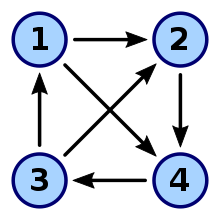A tournament solution is a function that maps an oriented complete graph to a nonempty subset of its vertices. It can informally be thought of as a way to find the "best" alternatives among all of the alternatives that are "competing" against each other in the tournament. Tournament solutions originate from social choice theory,[1][2][3][4] but have also been considered in sports competition, game theory,[5] multi-criteria decision analysis, biology,[6][7] webpage ranking,[8] and dueling bandit problems.[9]
In the context of social choice theory, tournament solutions are closely related to Fishburn's C1 social choice functions,[10] and thus seek to show who the best candidates are among all candidates.

Definition edit
A tournament (graph) is a tuple where is a set of vertices (called alternatives) and is a connex and asymmetric binary relation over the vertices. In social choice theory, the binary relation typically represents the pairwise majority comparison between alternatives.
A tournament solution is a function that maps each tournament to a nonempty subset of the alternatives (called the choice set[2]) and does not distinguish between isomorphic tournaments:
- If is a graph isomorphism between two tournaments and , then
Examples edit
Common examples of tournament solutions are:[1][2]
- Copeland's method
- Top cycle
- Slater set
- Bipartisan set
- Uncovered set
- Banks set
- Minimal covering set
- Tournament equilibrium set
References
- ^ a b Laslier, J.-F. [in French] (1997). Tournament Solutions and Majority Voting. Springer Verlag.
- ^ a b c Felix Brandt; Markus Brill; Paul Harrenstein (28 April 2016). "Chapter 3: Tournament Solutions" (PDF). In Felix Brandt; Vincent Conitzer; Ulle Endriss; Jérôme Lang; Ariel D. Procaccia (eds.). Handbook of Computational Social Choice. Cambridge University Press. ISBN 978-1-316-48975-8.
- ^ Brandt, F. (2009). Tournament Solutions - Extensions of Maximality and Their Applications to Decision-Making. Habilitation Thesis, Faculty for Mathematics, Computer Science, and Statistics, University of Munich.
- ^ Scott Moser. "Chapter 6: Majority rule and tournament solutions". In J. C. Heckelman; N. R. Miller (eds.). Handbook of Social Choice and Voting. Edgar Elgar.
- ^ Fisher, D. C.; Ryan, J. (1995). "Tournament games and positive tournaments". Journal of Graph Theory. 19 (2): 217–236. doi:10.1002/jgt.3190190208.
- ^ Allesina, S.; Levine, J. M. (2011). "A competitive network theory of species diversity". Proceedings of the National Academy of Sciences. 108 (14): 5638–5642. Bibcode:2011PNAS..108.5638A. doi:10.1073/pnas.1014428108. PMC 3078357. PMID 21415368.
- ^ Landau, H. G. (1951). "On dominance relations and the structure of animal societies: I. Effect of inherent characteristics". Bulletin of Mathematical Biophysics. 13 (1): 1–19. doi:10.1007/bf02478336.
- ^ Felix Brandt; Felix Fischer (2007). "PageRank as a Weak Tournament Solution" (PDF). Lecture Notes in Computer Science (LNCS). 3rd International Workshop on Internet and Network Economics (WINE). Vol. 4858. San Diego, USA: Springer. pp. 300–305.
- ^ Siddartha Ramamohan; Arun Rajkumar; Shivani Agarwal (2016). Dueling Bandits: Beyond Condorcet Winners to General Tournament Solutions (PDF). 29th Conference on Neural Information Processing Systems (NIPS 2016). Barcelona, Spain.
- ^ Fishburn, P. C. (1977). "Condorcet Social Choice Functions". SIAM Journal on Applied Mathematics. 33 (3): 469–489. doi:10.1137/0133030.


